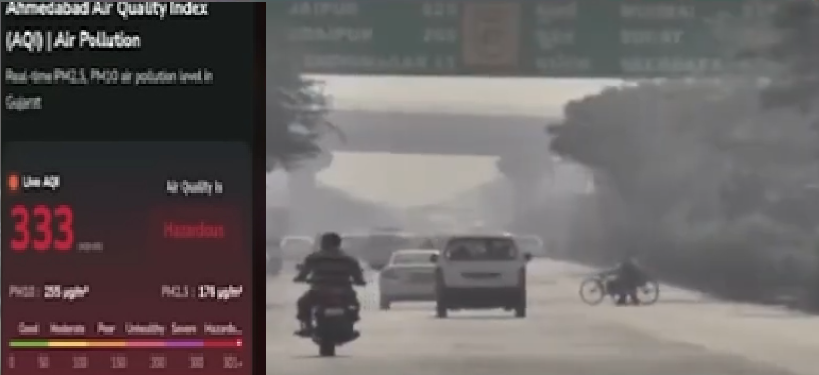AQI exceeds 300; 172 in Vatva, 200 in Satellite & Bopal crosses 289
A forecast by the Indian Institute of Tropical Meteorology (IITM) warned that major cities including Ahmedabad were expected to experience a sharp rise in fine-particulate pollution (PM2.5) around October 21, 2025, coinciding with Diwali firecracker use and weather conditions (cooler temperatures, weaker winds) that trap pollutants. Real-time data from air-monitoring network site (IQAir) for Gujarat showed Ahmedabad reaching AQI levels in the “moderate-to-poor” range (example: city reading ~ 125 on one listing).
Despite the restrictions in Ahmedabad on firecracker use and only “eco-friendly/green crackers” being allowed from 19 Oct to 5 Nov.
The combination of fire‐works, industrial and vehicular emissions, and meteorological conditions (cooling, low wind speeds) create favourable conditions for pollutants (especially PM2.5) to accumulate.
Even if Ahmedabad did not reach the extremely hazardous AQI levels seen in cities like Delhi, the pre‐Diwali forecast and the underlying data suggest the air quality was set to degrade significantly.
Health risks rise, particularly for children, the elderly, and those with respiratory or cardiovascular conditions.
Ahmedabad authorities issued restrictions limiting sale and use of only certified low‐emission “green crackers”; banning high‐pollution firecrackers, online sales, etc. (Oct 19–Nov 5). The Ahmedabad Municipal Corporation (AMC) is installing 100+ air quality sensors across the city (first phase) to monitor pollution in real‐time and identify hotspots. There is public criticism that despite large funds spent, Ahmedabad’s average AQI has remained very high year-on-year (for example AQI ~345 recorded as typical) and air-quality improvement has been slow.
Be alert: Even if the AQI number seems “moderate”, during Diwali pollution can quickly rise.
If you are outdoors (especially at night during firecracker activity) or near busy roads/industrial zones, consider minimizing exposure.
For those vulnerable (children, elderly, asthma/COPD sufferers) it might be wise to reduce time outdoors after Diwali.
Stay updated on the local AQI via apps or city sensors so you can make informed decisions about outdoor activity.





